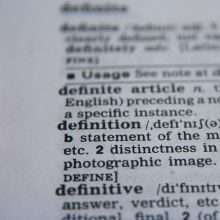JWG analysis.
In an article earlier this week, we highlighted some of the key challenges for firms engaged in HFT activities under MiFID II. In this piece, we will focus in more detail on one particular area of change under MiFID II, namely algorithmic trading and the implications of regulators rewriting the dictionary for it. As we see it, there are five new definitions.
What is an algorithm?
MiFID II provides what is arguably the tightest definition of algorithmic trading in global regulation as part of an ambitious attempt to enforce strict systems and controls on any use of algos in trading related activity. Under MiFID II, algorithmic trading means trading in financial instruments where a computer algorithm automatically determines individual parameters of orders. It is our understanding that the yet-to-be-published European Commission Delegated Acts will specify that Smart Order Routers do fall within this definition.
This definition will clearly bring a large amount of activity into the scope of MiFID II’s algo rules, potentially including non-order generating algos, such as those used in pre-trade quoting engines. However, the real question for firms implementing MiFID II is ‘do you have an inventory of all of your programmes that could fall under this definition and, if not, how difficult will it be to compile one?’
What counts as a material change in an algorithm?
The implication of programmes being caught under the algo definition is that they will be subject to the full set of pre-deployment controls, post-deployment controls and real time monitoring obligations contained within MiFID II.
One term that we do not yet have a definition for is a ‘material change’ in an algo. This term is crucial because, when an algo undergoes a material change, it essentially becomes an entirely new algo, and all new algos are subject to the full set of live and non-live testing requirements.
So, when an algo becomes a different algo, it must be re-tested, and what counts as a material change determines how often this will need to happen and, consequently, how expensive this requirement will be. Whether the regulators put in place a precise definition of a material change, or whether they essentially leave it up to firms themselves to determine when their algos materially change, will have a significant impact on the size of the regulatory burden imposed by the testing requirements.
What is HFT?
As well as defining algorithmic trading, MiFID II defines HFT as a subset of it. Under MiFID II, high-frequency algorithmic trading technique means an algorithmic trading technique characterised by: (a) infrastructure intended to minimise network and other types of latencies, including at least one of the following facilities for algorithmic order entry: co-location, proximity hosting or high-speed direct electronic access; (b) system-determination of order initiation, generation, routing or execution without human intervention for individual trades or orders; and (c) high message intraday rates which constitute orders, quotes or cancellations. We understand that the European Commission Delegated Acts will go further and define a high message intraday rate as the submission, on average, of at least four messages per second.
With this definition, MiFID II will become the first regulatory regime to identify specific firms as ‘HFT firms’, raising the question of what impact this will have as the EU push forward with their ever-expanding regulatory rulebook. There is the potential for a future piece of legislation specifically targeting firms that have identified as HFT firms under MiFID II.
What is DEA?
Direct Electronic Access (DEA) is defined in MiFID II to include both Direct Market Access and Sponsored Access (SA). Firms who offer services that fall under this definition will be subject to requirements to conduct due diligence on their prospective DEA clients and also to a range of pre-trade controls including direct monitoring and identification of instances of market abuse.
A key question for firms here is how will they capture the necessary information about third country clients who tend to represent a large portion of DEA users?
What does a description of an algorithm strategy look like?
Under article 17 of MiFID, national competent authorities (NCAs), such as the FCA in the UK, can ask for regular ad hoc descriptions of algo strategies for monitoring purposes. Firms will naturally raise concerns about giving up proprietary information to regulators, but there is a more fundamental question here; how do you describe an algo strategy? Ultimately, the answer may well be ‘however the requesting NCA wants you to’, but the details will be key to determine what types of records must be kept and how propriety the information to be reported to the authorities will be.
Definitional changes in regulatory policy are often overlooked as not being as impactful as concrete new requirements or prescriptive controls, but they have the potential to fundamentally change market rules and to set future regulatory agendas. Market participants must ensure that they have a firm view of what each of these definitions means in practice and what types of activity they will ultimately cover.


